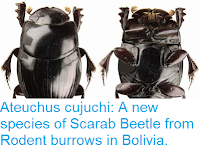Scarab Beetles, Scarabeidae, are a large and diverse group, containing
about 30 000 known species from around the world. These Beetles are
typically large and robust, and often with a metallic colouration. Many
Scarab Beetles are excellent diggers, and many of these digging Scarabs
share a habit of burying their eggs with a supply of dung to feed their
young, gaining them the name Dung Beetles, though others lay their eggs
on carrion, decaying plant matter, or in some cases living plants. Flower Chafers, Cetoniinae, are Scarab Beetles that feed as adults on the nectar and pollen of flowers. The larval habits of this group are variable, with some species predating the larvae of other Insects and others feeding on Bird Droppings - the later being particularly true of Southern African species. The genus Lamellothyrea was described by entomologist Jan Krikken from a single specimen from the Transvaal, in 1980. These Beetles have not subsequently been found in the Transvaal, though they are found in KwaZulu Natal Province, South Africa, and in the southern part of Mozambique. Recent studies of wild populations of Lamellothyrea have strongly indicated that the South African and Mozambican populations are in fact separate species.
In a paper published in the journal ZooKeys on 8 August 2017, Renzo Perissinotto of the School of Environmental Sciences at Nelson Mandela Metropolitan University, formally describes the KwaZulu Natal population of Lamellothyrea as a new species, having determined that the original Transvaal specimen having been determined to belong to the Mozambican species, so that this population retains the original species name (type species name), Lamellothyrea descarpentriesi.
The new species is named Lamellothyrea isimangalis, in reference to the the iSimangaliso Wetland Park, where most of the population is found. The females of this species are slightly larger than the males, at 21.2–21.8 mm, compared to 20.1–21.4 mm. The species is quite variable in colour, ranging from light brown to metallic purple to dark green. The larvae of this species are not known, but the adults were found on the flowers and fruits of the Dune Waterberry Tree, Sizygium cordatum, from November to December and February to March, which coincides with peak rainfall in the area.
Lamellothyrea isimangaliso in its natural habitat at St Lucia Estuary. Lynette Clennell in Perissonotto (2017).
Lamellothyrea isimangalis was found prodominantly within the iSimangaliso Wetland Park, with a small population around Lake Nhlabane, roughly 10 km to the southeast of the park. The population outside that park is apparently vulnerable to coastal dune mining, though the majority of the population should be safe due to the high level of protection within the iSimangaliso Wetland Park.
Typical habitat of Lamellothyrea isimangaliso in the coastal forest on the Eastern Shores of Lake St Lucia. Nicola Carrasco in Perissonotto (2017).
See also...
Follow Sciency Thoughts on Facebook.








